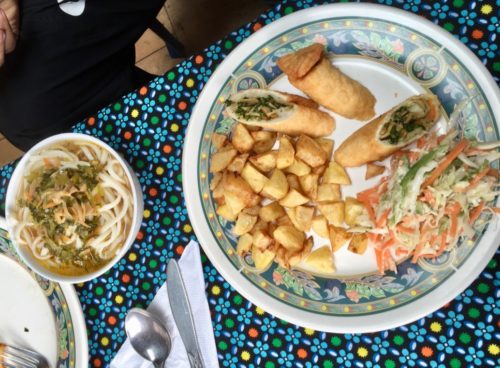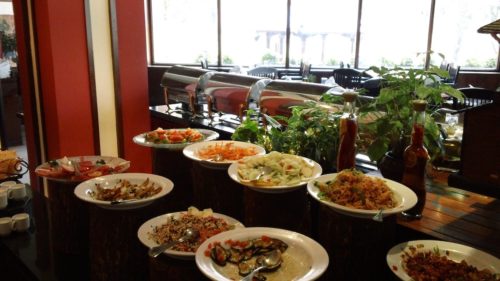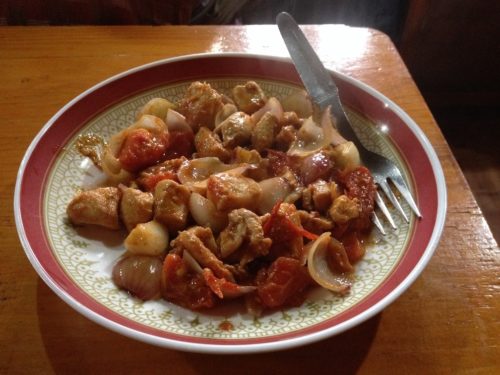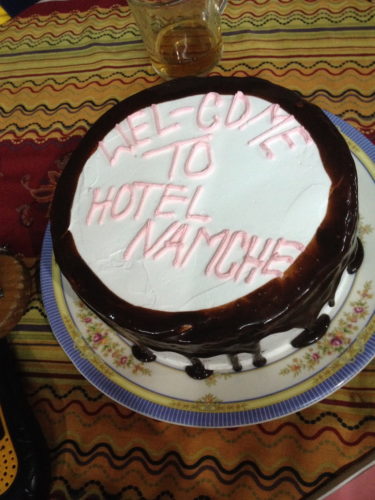
What’s the food in Nepal like?
This is a pretty stock standard question for anyone preparing to embark on a trek in Nepal.
Understandably, some approach the subject of food in Nepal with a nervous trepidation. And avoiding the Kathmandu quickstep and Dehli belly will almost certainly mean a better experience for all! So what are you in for food wise when you sign up for a trekking holiday in Nepal.
I’m here to tell you, you don’t need to be scared. The food in Nepal can actually be very good. And thoroughly enjoying some of the food on offer should be a highlight of your trip. It’s true the menus you’ll come across won’t feature the usual pub favourites like chicken parmigiana, fish and chips, scotch fillet steak, lamb shanks and calamari rings. In fact, lovers of seafood are going to need to abstain totally from all ocean fare while in the land-locked country of Nepal. Tinned sardines are the exception.

So if none of that stuff is available what can you expect? When out on the trail, you’ll generally have two options for meals and these will largely depend on the style of trek you have joined. If you are on a camping trip, chances are your trekking staff will include a cook and a number of kitchen boys. You will marvel at how each day they’ll manage to prepare, cook and serve you three fantastic meals. Chances are it will be “all you can eat” for every meal. Typically the meals will include things like:
Breakfast: Local breads, pancakes, eggs, porridge, cereals, fruit, tea, coffee and hot chocolate
Lunch: Soup, vegetables, salads, breads, cheese, pasta, tinned meat or fish, potatoes and rice
Dinner: Multi-courses including soup, vegetables, salads, a meat dish (e.g. chicken), traditional Nepali curries, Japanese tempura (yes, you read that correctly!), cakes and desserts
If you travel with a reputable company that have a good expedition cook, you’re in for a real treat. This has always been our favourite way to eat when in the mountains as there are plenty of options to choose from for each meal and the food hygiene and preparation is usually A1.

Lodge/Teahouse style treks require that the trekking group order their meals from the menus that are supplied by the lodge. If you are staying in their lodge, they want you to spend money on their food which is fair enough. And this too is a reliable and generally hygienic way to have your meals along the way. We use the word “generally” because all lodges and teahouses in Nepal are not the same. Like anywhere there are the good and the not so good. Reputable companies know all the good lodges and they will have booked their accommodation requirements at those venues well in advance. Before they all had phones, it wasn’t uncommon for trekking agencies to send a “runner”. The “runner” would be travel one day ahead of the main group making reservations for them in advance along the way. It was a system that worked well until mobile phone towers were erected all the way to Everest Base Camp!
The lodge menus will generally feature every version of eggs, potato, rice and pasta you can imagine. Plenty of soups, breads and homemade cakes for dessert. We recommend you always avoid the Yak steaks and Buffalo burgers. There’s no telling what type of meat it might be or for how long it’s been sitting unrefrigerated. If they’re advertising chicken and you can see chickens roaming around the place then chances are the chicken will be fresh! Don’t hesitate to ask about any of the food in Nepal you’re not sure about. Most of the Sherpa families preparing the meals for you will be only too happy to answer your questions – and the good ones will happily give you a tour of their kitchen!

Insider tip: Don’t hesitate to ask whoever is preparing your meals for an authentic Nepalese style meal. Nepalese cooks have got very good at “westernising” much of the food they’ll prepare for the tourists. This can sometimes result in fairly bland tasting curries, sauces and soups. If chilli, garlic and ginger don’t scare you, now and then be sure to ask for the same meal your guides and porters are being served. You’ll be glad you did.
Super insider tip: Don’t ever take on the Nepalese in a chilli eating contest.